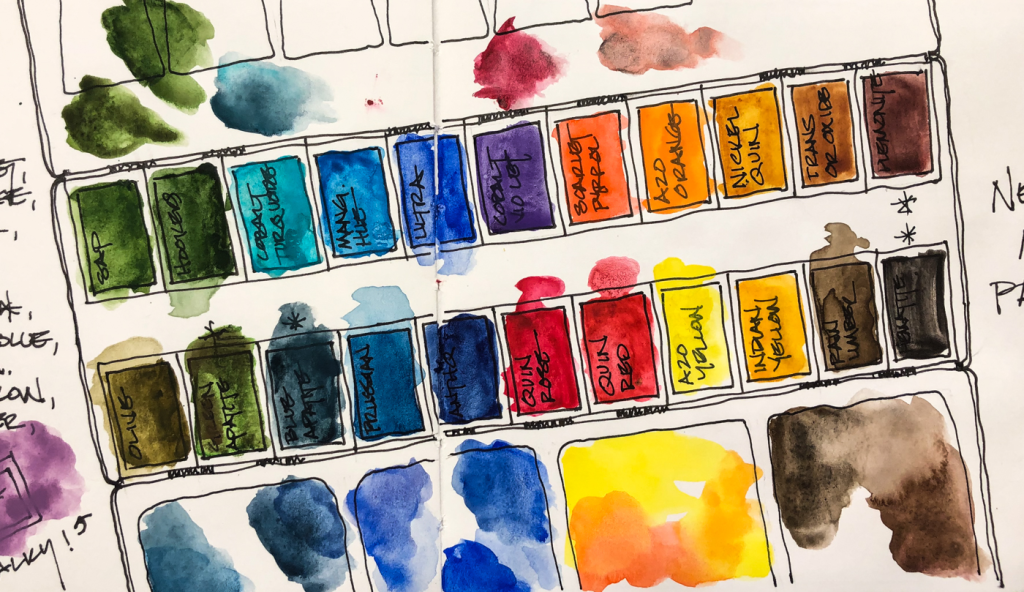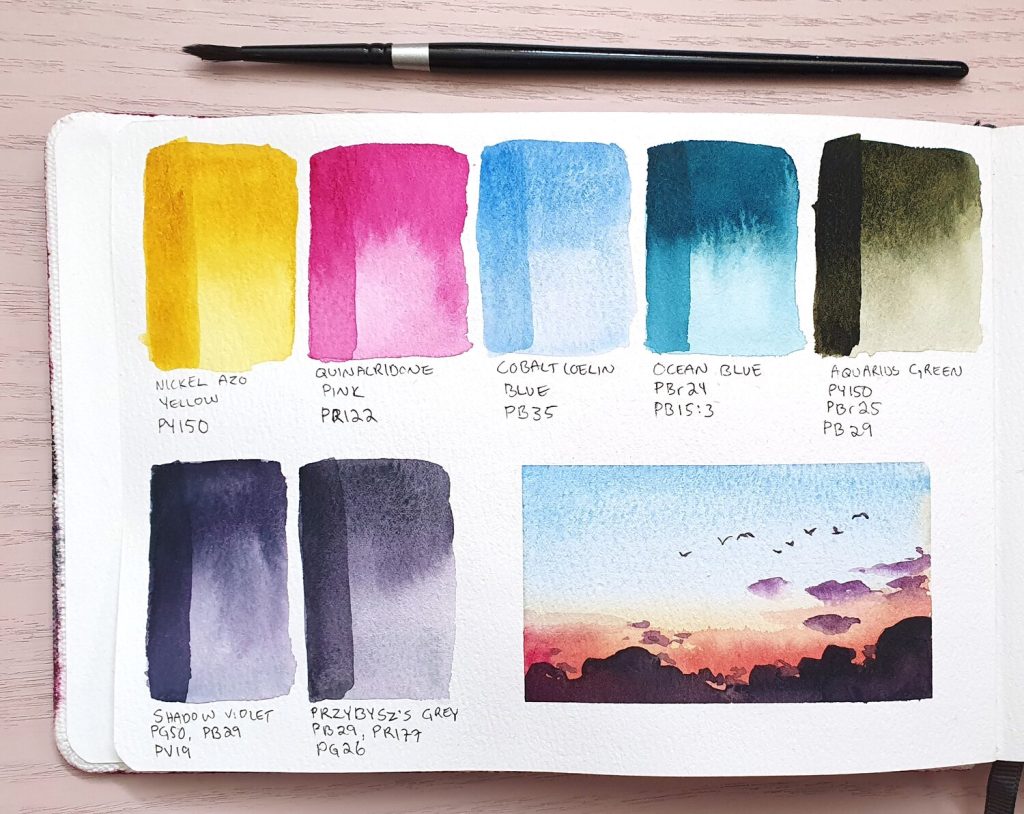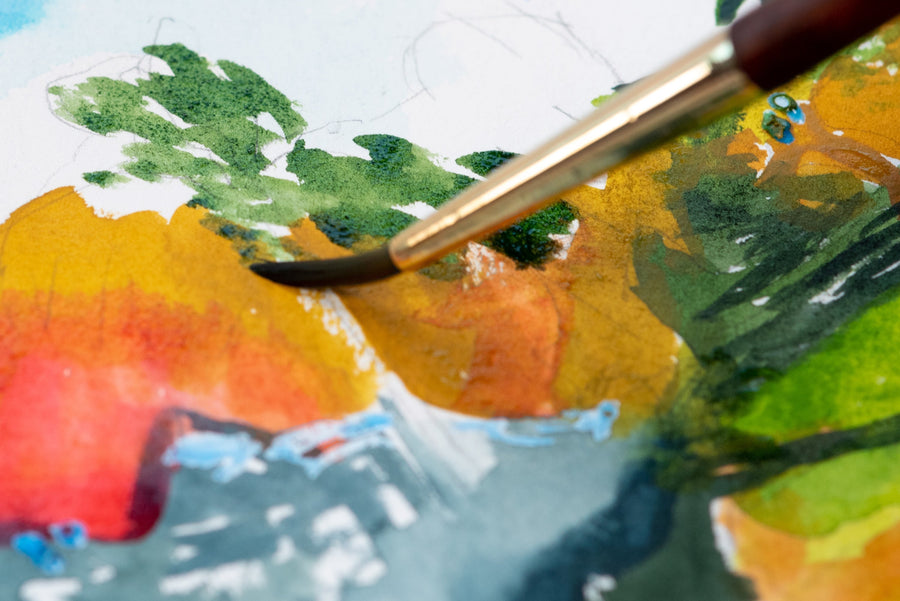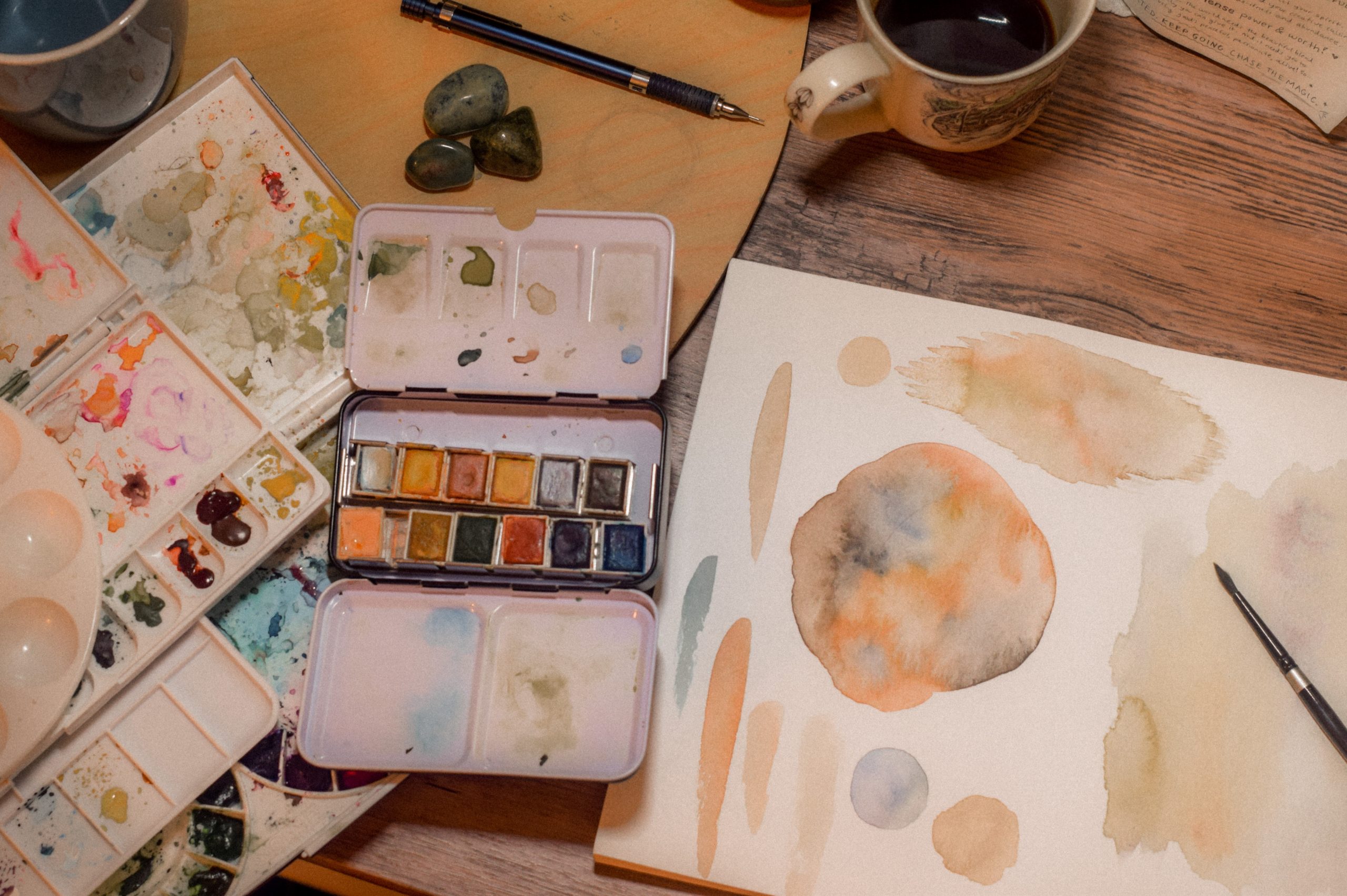All-in-one review will help you arrive at a decision for which watercolor brand to buy from.
Daniel Smith

Daniel Smith watercolors are artist-grade paints formulated for premium performance.
These paints are significantly better than any student-grade brand set you will find, designed to dry well without cracking; reactivate by water with ease; and are richly pigmented with exceptional granulation.
Daniel Smith’s speciality watercolor pigments are renowned for their vibrant layering and excellent lightfastness.
For example:
The Daniel Smith Luminescent watercolors that are available in 15ml tubes are one of the brand’s specialty colors manufactured with optical effects typically discovered in nature that conventional pigments cannot replicate.
Their luminous quality, observed as an iridescent sheen, are derived from those seen in birds’ feathers, insects, fish and other natural materials designed to meet and exceed the highest industry standards just as the rest of the brand’s watercolor catalog.
| Pros of Daniel Smith | Cons of Daniel Smith |
| High color variety (261 colors including exclusive pigments) Strong granulation Deeply pigmented Larger tube sizing Long-lasting | Higher pricing Pigment may be too intense |
Schmincke Horadam

Schmincke Horadam watercolors are high quality, artist-grade paints formulated to achieve the highest standard of lightfastness, solubility and stability.
The brand embraces raw materials without compromising the quality of its watercolor paints.
For example, Schmincke Horadam ensures the optimal amount of ox-gall added to each pigment to provide artists’ absolute control with the distribution of color.
Schmincke Horadam goes above and beyond in its material choice, ensuring the highest integrity and quality of Gum Arabic used by judiciously selecting the best crop of the year made clear by the absolutely stunning quality of its granulating colors and pigment even when diluted.
However…
The brand’s watercolors dilute and disperse easily in water which results in a lack of control, disadvantageous to those who do not appreciate a loose hand.
You may also be subject to unexpected blossoming caused by over dilution making techniques such as wet-in-wet, glazes and washes difficult to control.
| Pros of Schmincke Horadam | Cons of Schmincke Horadam |
| High color variety (261 colors including exclusive pigments) Strong granulation Deeply pigmented Larger tube sizing Long-lastingModerate color variety (140 colors) Ease of reactivation High granulation Long-lasting | Higher pricing Harder to buy new colors Larger palette size difficult for traveling Harder to blend and may cause patchiness due to blossoming |
M. Graham

Credit: D.Katie Powell Art
Daniel Smith watercolors are artist-grade paints formulated for professional use.
These paints are significantly better than any student-grade set you will find, designed to dry well without cracking; reactivate by water with ease; and are richly pigmented with exceptional granulation.
Daniel Smith’s speciality watercolor pigments are renowned for their vibrant layering and excellent lightfastness.
For example, the Daniel Smith Luminescent watercolors that are available in 15ml tubes are one of the brand’s specialty colors manufactured with optical effects typically discovered in nature that conventional pigments cannot replicate.
Their luminous quality, observed as an iridescent sheen, is derived from those seen in birds’ feathers, insects, fish and other natural materials designed to meet and exceed the highest industry standards as the rest of the brand’s watercolor catalog.
| Pros of M. Graham | Cons of M. Graham |
| Highly pigmented and rich Resists hardening on palette Stays | Relatively low color variety (70 colors) Paints may react harmfully with hot temperatures and humidity Dilute easily often after months of disuse Less suitable for reuse |
Da Vinci

Da Vinci’s high quality watercolor paints are manufactured in the USA for artist-grade use.
The professionally made pigments are incredibly consistent akin to those of Daniel Smith in performance but are much more affordable in price.
The trade-off however is the more restricted selection of granulating or rare speciality pigments offered by Daniel Smith, although having a respectable catalog of 112 non-granulating colors.
The brand’s watercolors have a heavy pigment load with their earthy tones being some of the most vibrant and renowned across other artist-grade watercolor brands. Some favorite paints include Burnt Umber PBr7, Terra Cotta PR102 and Nickel Azo Yellow PY150 with outstanding color ranges and gentle granulation capable of adding nuanced flares to your paintings.
Compared to other reputable brands…
Da Vinci’s paints are better suited using wash techniques and smooth color gradients, however, some have been found to fade under direct sunlight exposure such as their OPUS Vivid pink.
| Pros of Da Vinci | Cons of Da Vinci |
| Moderate color variety (112 non-granulating colors with some exceptions) Ease of reactivation Vibrancy and pigment load | Reduced granulation Lack of specialty paints (e.g. Daniel Smith’s rare mineral paints) Certain fugitive colors (e.g. OPUS Vivid Pink) Dry lighter compared to when wet (can be deceiving) |
Sennelier

Sennelier watercolors are professional, artist-grade honey-based paints made in France.
The brand’s paints are grounded by the Impressionist school whereby painters drew their inspiration from nature in an attempt to reproduce the playful character of natural light.
They are characterized as smooth paints with a minimal granulating earth range, capable of exceptionally clean gradients and glazed layers optimal for botanical art (using their colors such as Forest Green, Olive Green and Chinese Orange). Compared to brands such as Schmincke Horadam’s watercolor, Sennelier’s range possesses a relatively low flow and dispersion rate, enabling a greater degree of control.
Specific individual pigment colors that are recommended by various artists include the Quin Red PR209, Caput Mortum and Turquoise Green PG50.
The main fault that detracts from the overall quality of the brand includes the lack of ability to create color separating mixtures and overly textural quality when dried.
| Pros of Sennelier | Cons of Sennelier |
| Excellent granulation Lightfast drying Ease of reactivation Rich pigmen Blendability Tube longevity Metal tubes (enabling accurate volumes of paint being squeezed) | Small color variety (98 standard colors) High price point Dry sticky (not runny compared to M. Graham) |
Rembrandt

Rembrandt watercolors is the artist-grade line created by Royal Talens in the Netherlands.
The paints are renowned for their high quality pigments, lightfast colors and high pigment load. If you are looking for an overall great, professional quality brand with a moderate to high price tag, definitely go with Rembrandt’s catalog of premium paints.
However…
If you truly are looking for the best intensity and consistency of pigment, you will be better off choosing the watercolor selections from brands such as Daniel Smith or Schmincke as mentioned above.
It should also be considered that Rembrandt’s watercolor’s lack texture is relative to the heavily granulating textural paints of Daniel Smith.
| Pros of Rembrandt | Cons of Rembrandt |
| Moderate color variety (120 colors) Vibrant and luminous colors Premium glazing Rare pigment selection | Small color variety (98 standard colors) High price point Lacks texture |
Roman Szmal

The watercolors of professional Poland artist, Roman Szmal, called “Aquarius” is specialized as honey-based watercolors with rare, unusual and more granulating pigments.
Paints are characterized by the magical separation, high saturation and softness when applying.
| Pros of Roman Szmal | Cons of Roman Szmal |
| High color variety (261 colors including exclusive pigments) Strong granulation Deeply pigmented Larger tube sizing Long-lasting | Limited color selection in pan sets (single yellow) Some pigments are not as vibrant such as the browns |
Holbein

Holbein Artist Watercolors were originally introduced in the early 1920’s as specialized transparent paint that preserves the brush handling qualities grounded traditionally by Japanese watercolor techniques.
The professional grade watercolor is beautifully pigmented with deep colors and are easy to achieve a saturated wash.
In terms of smoothness…
Holbein paints are smooth and creamy, very easy to hydrate and not grainy at all. Despite the saturation colors, some pigments appear flat with limited granulating and depth.
| Pros of Holbein | Cons of Holbein |
| Moderate color variety (120 colors available) Saturated wash Deep pigment Smooth and creamy Ease of reactivation | Limited granulation Lack of depth in colors At times pigments appear flat |
Paul Rubens

Holbein Artist Watercolors were originally introduced in the early 1920’s as specialized transparent paint that preserves the brush handling qualities grounded traditionally by Japanese watercolor techniques.
The professional grade watercolor is beautifully pigmented with deep colors and are easy to achieve a saturated wash.
In terms of smoothness, Holbein paints are smooth and creamy, very easy to hydrate and not grainy at all. Despite the saturation colors, some pigments appear flat with limited granulating and depth.
| Pros of Paul Rubens | Cons of Paul Rubens |
| Inexpensive Ease of reactivation Highly pigmented Quality of paint Limited color variety Labeling errors and incorrect pigment codes Deceiving descriptions (e.g. lightfast pigments were fugitive) | Limited granulation Lack of depth in colors At times pigments appear flat |



Leave a Reply